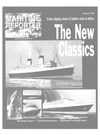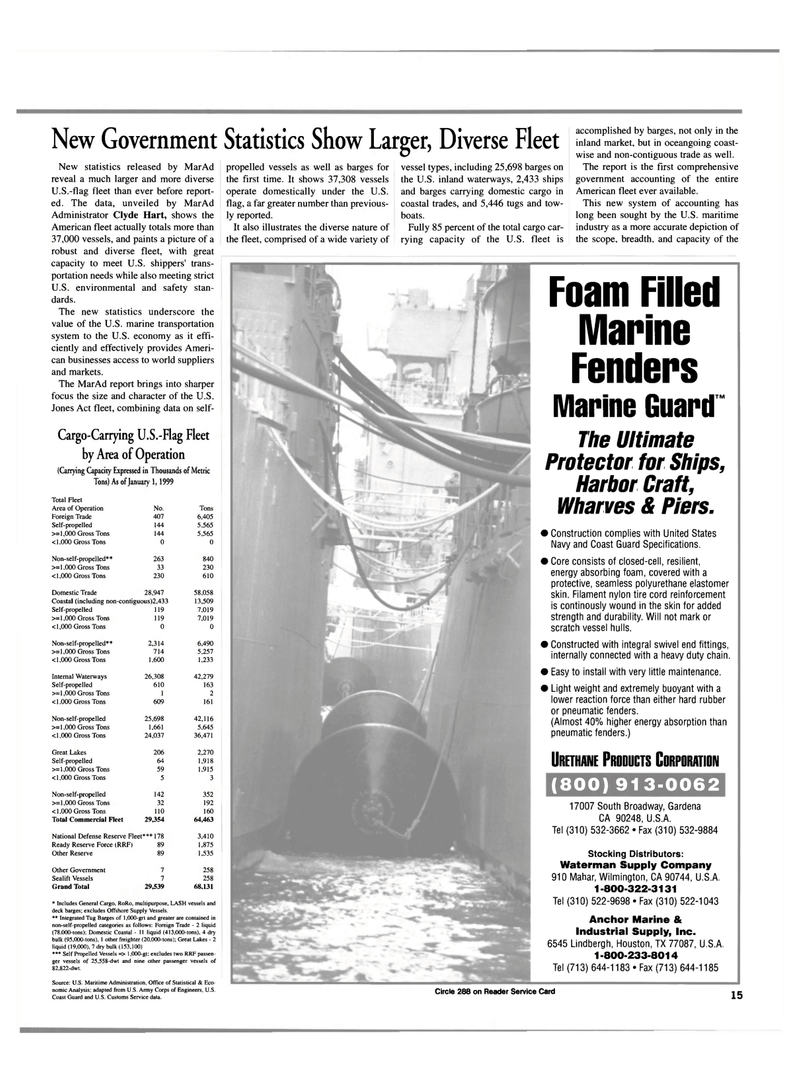
Page 15: of Maritime Reporter Magazine (February 2000)
Read this page in Pdf, Flash or Html5 edition of February 2000 Maritime Reporter Magazine
New Government
New statistics released by MarAd reveal a much larger and more diverse
U.S.-flag fleet than ever before report- ed. The data, unveiled by MarAd
Administrator Clyde Hart, shows the
American fleet actually totals more than 37,000 vessels, and paints a picture of a robust and diverse fleet, with great capacity to meet U.S. shippers' trans- portation needs while also meeting strict
U.S. environmental and safety stan- dards.
The new statistics underscore the value of the U.S. marine transportation system to the U.S. economy as it effi- ciently and effectively provides Ameri- can businesses access to world suppliers and markets.
The MarAd report brings into sharper focus the size and character of the U.S.
Jones Act fleet, combining data on self-
Cargo-Carrying U.S.-Flag Fleet by Area of Operation (Carrying Capacity Expressed in Thousands of Metric
Tons) As of January 1, 1999
Total Fleet
Area of Operation No. Tons
Foreign Trade 407 6,405
Self-propelled 144 5,565 >=1,000 Gross Tons 144 5,565 <1,000 Gross Tons 0 0
Non-self-propelled** 263 840 >=1,000 Gross Tons 33 230 <1,000 Gross Tons 230 610
Domestic Trade 28,947 58,058
Coastal (including non-contiguous)2,433 13,509
Self-propelled 119 7,019 >=1,000 Gross Tons 119 7,019 <1,000 Gross Tons 0 0
Non-self-propelled* * 2,314 6,490 >=1,000 Gross Tons 714 5,257 <1,000 Gross Tons 1.600 1,233
Internal Waterways 26,308 42,279
Self-propelled 610 163 >=1,000 Gross Tons 1 2 <1,000 Gross Tons 609 161
Non-self-propelled 25,698 42,116 >=1,000 Gross Tons 1,661 5,645 <1,000 Gross Tons 24,037 36,471
Great Lakes 206 2,270
Self-propelled 64 1,918 >=1,000 Gross Tons 59 1,915 <1,000 Gross Tons 5 3
Non-self-propelled 142 352 >=1,000 Gross Tons 32 192 <1,000 Gross Tons 110 160
Total Commercial Fleet 29,354 64,463
National Defense Reserve Fleet*** 178 3,410
Ready Reserve Force (RRF) 89 1,875
Other Reserve 89 1,535
Other Government 7 258
Sealift Vessels 7 258
Grand Total 29,539 68,131 * Includes General Cargo, RoRo, multipurpose, LASH vessels and deck barges; excludes Offshore Supply Vessels. ** Integrated Tug Barges of 1,000-grt and greater are contained in non-self-propelled categories as follows: Foreign Trade - 2 liquid (78,000-tons); Domestic Coastal - 11 liquid (413,000-tons), 4 dry bulk (95,000-tons), 1 other freighter (20,000-tons); Great Lakes - 2 liquid (19,000), 7 dry bulk (153,100) *** Self Propelled Vessels => 1,000-gt; excludes two RRF passen- ger vessels of 25,558-dwt and nine other passenger vessels of 82,822-dwt.
Source: U.S. Maritime Administration, Office of Statistical & Eco- nomic Analysis; adapted from U.S. Army Corps of Engineers, U.S.
Coast Guard and U.S. Customs Service data.
Statistics Show Larger, Diverse Fleet propelled vessels as well as barges for the first time. It shows 37,308 vessels operate domestically under the U.S. flag, a far greater number than previous- ly reported.
It also illustrates the diverse nature of the fleet, comprised of a wide variety of vessel types, including 25,698 barges on the U.S. inland waterways, 2,433 ships and barges carrying domestic cargo in coastal trades, and 5,446 tugs and tow- boats.
Fully 85 percent of the total cargo car- rying capacity of the U.S. fleet is accomplished by barges, not only in the inland market, but in oceangoing coast- wise and non-contiguous trade as well.
The report is the first comprehensive government accounting of the entire
American fleet ever available.
This new system of accounting has long been sought by the U.S. maritime industry as a more accurate depiction of the scope, breadth, and capacity of the
Foam Filled
Marine
Fenders
Marine Guard "
The Ultimate
Protector for Ships,
Harbor Craft,
Wharves & Piers. • Construction complies with United States
Navy and Coast Guard Specifications. • Core consists of closed-cell, resilient, energy absorbing foam, covered with a protective, seamless polyurethane elastomer skin. Filament nylon tire cord reinforcement is continously wound in the skin for added strength and durability. Will not mark or scratch vessel hulls. • Constructed with integral swivel end fittings, internally connected with a heavy duty chain. • Easy to install with very little maintenance. • Light weight and extremely buoyant with a lower reaction force than either hard rubber or pneumatic fenders. (Almost 40% higher energy absorption than pneumatic fenders.)
URETHAIYE PRODUCTS CORPORATION (800) 913-0062 17007 South Broadway, Gardena
CA 90248, U.S.A.
Tel (310) 532-3662 • Fax (310) 532-9884
Stocking Distributors:
Waterman Supply Company 910 Mahar, Wilmington, CA 90744, U.S.A. 1-800-322-3131
Tel (310) 522-9698 • Fax (310) 522-1043
Anchor Marine &
Industrial Supply, Inc. 6545 Lindbergh, Houston, TX 77087, U.S.A. 1-800-233-8014
Tel (713) 644-1183 • Fax (713) 644-1185
Circle 288 on Reader Service Card 15

 14
14

 16
16
